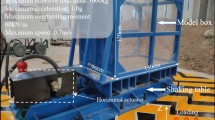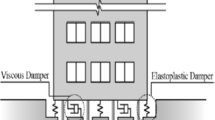Abstract
Many breakwaters have collapsed in the past due to earthquakes and subsequent tsunamis, resulting in considerable devastation as the breakwaters failed to prevent the tsunami from entering the coastal plain areas. Breakwater failures are mainly caused by damage to its foundation ground. However, the damage mechanism of breakwater foundation during earthquakes and tsunamis remains unclear. This study focuses on the breakwater failure mechanism due to collapse of its foundation under the action of an earthquake and subsequent tsunami. In addition, reinforcing countermeasures for breakwater foundation to mitigate damage due to compound geodisasters triggered by earthquakes and tsunamis are proposed. Sheet piles and gabions were used in the breakwater foundation as reinforcing countermeasures. To evaluate the effectiveness of the reinforced foundation, a series of shaking table tests and hydraulic model tests were performed. The tsunami overflow tests were conducted on the same model after the earthquake loadings, and comparisons were made between the conventional and reinforced foundations. It was observed during the tests that the reinforced foundation could effectively reduce the damage to the breakwater caused by earthquake and tsunami-induced forces. Numerical analyses were performed to clarify the mechanism of the soil–breakwater–reinforcement–fluid system. Overall, this study is useful in practical engineering, and the reinforcing foundation model could be adopted for offshore structures to reduce damage from earthquakes and tsunamis in the future.























Similar content being viewed by others
References
Arikawa T, Sato M, Shimosako K, Hasegawa I, Yoem GS, Tomita T (2012) Failure mechanism of Kamaishi breakwater due to the Great East Japan earthquake tsunami. In: 33rd Conference on coastal engineering, Santander, Spain, pp 1–13
Arikawa T, Sato M, Shimosako K, Tomita T, Yeom GS, Niwa T (2013) Failure mechanism and resiliency of breakwater under tsunami. Technical Note No. 1269, Port and Airport Research Institute, Japan (in Japanese)
Bhattacharjee A, Krishna AM (2015) Strain behavior of backfill soil in rigid faced reinforced soil walls subjected to seismic excitation. Int J Geosynth Ground Eng 1:14
Boulanger RW, Ziotopoulou K (2013) Formulation of a sand plasticity plane-strain model for earthquake engineering applications. Soil Dyn Earthq Eng 53:254–267
Byrne P (1991) A cyclic shear-volume coupling and pore-pressure model for sand. In: 2nd International conference on recent advances in geotechnical earthquake engineering and soil dynamics, St. Louis, Missouri, vol 1(24), pp 47–55
Central Disaster Management Council (2003) Report of the 16th committee meeting. Investigation Committee on Tonankai Earthquake and Nankai Earthquake. Cabinet Office, Government of Japan (in Japanese)
Chaudhary B, Hazarika H, Nishimura K (2016) Effects of reinforcement on the performance of breakwater foundation subjected to earthquake loadings. Int J Geotech Eng 11(2):186–197
Chaudhary B, Hazarika H, Pasha SMK (2017) Countermeasures for breakwater foundation subjected to foreshocks and main shock of earthquake loading. Mar Georesour Geotechnol. https://doi.org/10.1080/1064119X.2017.1313342
Chaudhary B, Hazarika H, Nishimura K (2017) Effects of duration and acceleration level of earthquake ground motion on the behavior of unreinforced and reinforced breakwater foundation. Soil Dyn Earthq Eng 98:24–37
Dafalias YF, Manzari MT (2004) Simple plasticity sand model accounting for fabric change effects. J Eng Mech 130(6):622–634
Elgamal A, Yang Z, Parra E (2002) Computational modeling of cyclic mobility and post-liquefaction site response. Soil Dyn Earthq Eng 22(4):259–271
FLAC-Fast Lagrangian Analysis of Continua (2005) Ver. 5.0. Itasca Consulting Group Inc., Minneapolis
Guler HG, Arikawa T, Oei T, Yalciner AC (2015) Performance of rubble mound breakwaters under tsunami attack, a case study: Haydarpasa Port, Istanbul, Turkey. Coast Eng 104:43–53
Hazarika H, Kataoka S, Kasama K, Kaneko K, Suetsugu D (2012) Composite ground disasters caused by the earthquake and tsunami in Aomori, Iwate Prefecture, northern. Geotech Eng J Spec Issue 2011 Great East Jpn Earthq 7(1):13–23 (in Japanese)
Hazarika H, Kasama K, Suetsugu D, Kataoka S, Yasufuku N (2013) Damage to geotechnical structures in waterfront areas of northern Tohoku due to the March 11, 2011 tsunami disaster. Indian Geotech J 43(2):137–152
Hazarika H, Chaudhary B, Nishimura K, Kasama K, Noda T, Yamada S (2015) Physical and numerical modeling of resilient breakwater foundation subjected to earthquake and tsunami. In: 50th Indian geotechnical conference, Pune, India
Hazarika H, Chaudhary B, Monji N, Ishikura R, Kasama K, Hara T, Yamazaki N, Noda T, Yamada S (2015) Resilient breakwater foundation against level II earthquake and tsunami. In: 6th International geotechnical symposium on disaster mitigation in special geoenvironmental conditions, Chennai, India, pp 35–46
Hazarika H, Hara T, Nishimura K, Yamasaki N, Monji N, Chaudhary B, Ishikura R, Kasama K (2016) Fundamental study on seismic resistant behavior of caisson type breakwater foundation reinforced by steel sheet pile and gabion. J Jpn Assoc Earthq Eng 16(1):184–204 (In Japanese)
Iai S (1989) Similitude for shaking table tests on soil–structure–fluid model in 1 g gravitational field. Soils Found 29(1):105–118
Idriss IM, Boulanger RW (2008) Soil liquefaction during earthquakes. Earthquake Engineering Research Institute, Oakland
Jafarian Y, Alielahi H, Abdollahi AS, Vakili R (2010) Seismic numerical simulation of breakwater on a liquefiable layer: Iran LNG port. Electron J Geotech Eng 15(D):1–11
Kazama M, Noda T (2012) Damage statistics (summary of the 2011 off the Pacific Coast of Tohoku Earthquake damage). Soils Found 52(5):780–792
Kikuchi Y, Kawabe S, Takaenaka S, Moriyasu S (2015) Horizontal loading experiments on reinforced gravity type breakwater with steel walls. Jpn Geotech Soc Spec Publ 2(35):1267–1272
Kishida T, Hoshino F, Tasaki K, Iwamae N, Akiyama Y, Ikeya T (2013) The experiment about the stability over the tsunami of the breakwater by friction-increasing asphalt mat. J Jpn Soc Civil Eng Ocean Eng Ser B3 69(2):I_467–I_472 (in Japanese)
Krishna AM, Latha GM (2016) Modeling the dynamic response of wrap-faced reinforced soil retaining walls. Int J Geomech 12(4):439–450
Liu H, Wang X, Song E (2011) Reinforcement load and deformation mode of geosynthetics-reinforced soil walls subject to seismic loading during service life. Geotext Geomembr 29:1–16
Madsen PA, Fuhrman DR, Schaffer HA (2008) On the solitary wave paradigm for tsunamis. J Geophys Res 113(C12012):1–22
Mitsui J, Maruyama S, Matsumoto A, Hanzawa M (2012) Stability of armor units covering harbor-side rubble mound of composite breakwater against tsunami overflow. Journal of Japan Society of Civil Engineers, Ocean Engineering, Ser. B2 68(2):I_881–I_885 (in Japanese)
Mitsui J, Matsumoto A, Hanzawa M, Koyama H, Shinomura Y, Oike N (2013) Effective methods for covering breakwater rubble mounds against tsunami using filter units. J Jpn Soc Civil Eng Ocean Eng Ser B3 69(2):I_479–I_484 (in Japanese)
Saman SK, Asskar JC (2015) Mesh-free modeling of liquefaction around a pipeline under the influence of trench layer. Acta Geotech 10:343–355
Seed HB, Lee KL (1966) Liquefaction of saturated sands during cyclic loading. J Soil Mech Found Div ASCE 92(6):105–134
Silvana MN, Fernando LC (2016) Effect of coupling excess pore pressure and deformation on nonlinear seismic soil response. Acta Geotech 11:191–207
Sugano T, Nozu A, Kohama E, Shimosaka KI, Kikuchi Y (2014) Damage to coastal structures. Soils Found 54(4):883–901
Suppasri A, Muhari A, Ranasinghe P, Mas E, Shuto N, Imamura F, Koshimura S (2012) Damage and reconstruction after the 2004 Indian Ocean tsunami and the 2011 Great East Japan tsunami. Journal of Natural Disaster Science 34(1):19–39
Takahashi S, Kuriyama Y, Takashi T, Kawai Y, Arikawa T, Tatsumi D, Negi T (2011) Urgent survey for 2011 Great East Japan earthquake and tsunami disaster in ports and coasts part I (tsunami). Technical Note 1231, Port and Airport Research Institute, Japan, pp 1–9
Takahashi H, Sassa S, Morikawa Y, Takano D, Aoki R, Maruyama K (2014) Centrifuge tests on resistance force of breakwaters reinforced by embankment. J Jpn Soc Civil Eng Ocean Eng Ser B3 70(2):I_870–I_875 (in Japanese)
Takahashi H, Sassa S, Morikawa Y, Takano D, Maruyama K (2014) Stability of caisson-type breakwater foundation under tsunami-induced seepage. Soils Found 54(4):789–805
Tokimatsu K, Seed HB (1987) Evaluation of settlements in sands due to earthquake shaking. J Geotech Eng 113(8):861–878
Tsujio D, Yasuda T, Mase H, Mori N, Maeda K, Yamaguchi Y (2013) Experimental study on effects of reinforcement for caisson breakwater against abnormal tsunami. J Jpn Soc Civil Eng Ocean Eng Ser B3 69(2):I_473–I_478 (in Japanese)
Ueda K, Iai S, Tobita T (2016) Centrifuge model tests and large deformation analyses of a breakwater subject to combined effects of tsunami. Soil Dyn Earthq Eng 91:294–303
Wang R, Zhang JM, Wang G (2014) A unified plasticity model for large post-liquefaction shear deformation of sand. Comput Geotech 59:54–66
Ye JH, Wang G (2015) Seismic dynamics of offshore breakwater on liquefiable seabed foundation. Soil Dyn Earthq Eng 76:86–99
Zhang JM, Wang G (2012) Large post-liquefaction deformation of sand, part I: physical mechanism, constitutive description and numerical algorithm. Acta Geotech 7:69–113
Acknowledgements
For the study, financial support was provided by the Japan Iron and Steel Federation under the priority themes research grant. The authors express deep gratitude for this financial support. The authors extend special thanks to associate professor Kiyonobu Kasama of Kyushu University for his cooperation and support in the physical model tests. The authors are also thankful to Mr. Yuichi Yahiro and Mr. Michio Nakashima of Kyushu University, Japan, for their valuable help during the experiments. The authors would also like to express their gratitude to the unknown reviewers for providing valuable comments to improve the quality of the paper.
Author information
Authors and Affiliations
Corresponding author
Rights and permissions
About this article
Cite this article
Chaudhary, B., Hazarika, H., Murakami, A. et al. Countermeasures for enhancing the stability of composite breakwater under earthquake and subsequent tsunami. Acta Geotech. 13, 997–1017 (2018). https://doi.org/10.1007/s11440-017-0615-4
Received:
Accepted:
Published:
Issue Date:
DOI: https://doi.org/10.1007/s11440-017-0615-4




